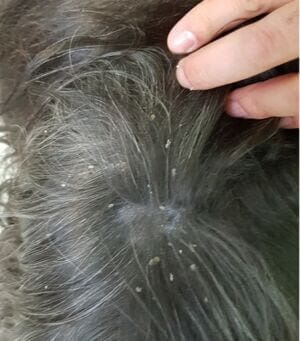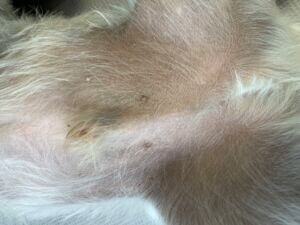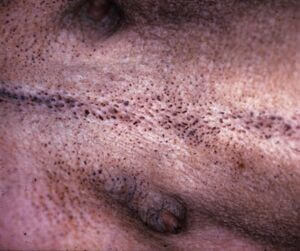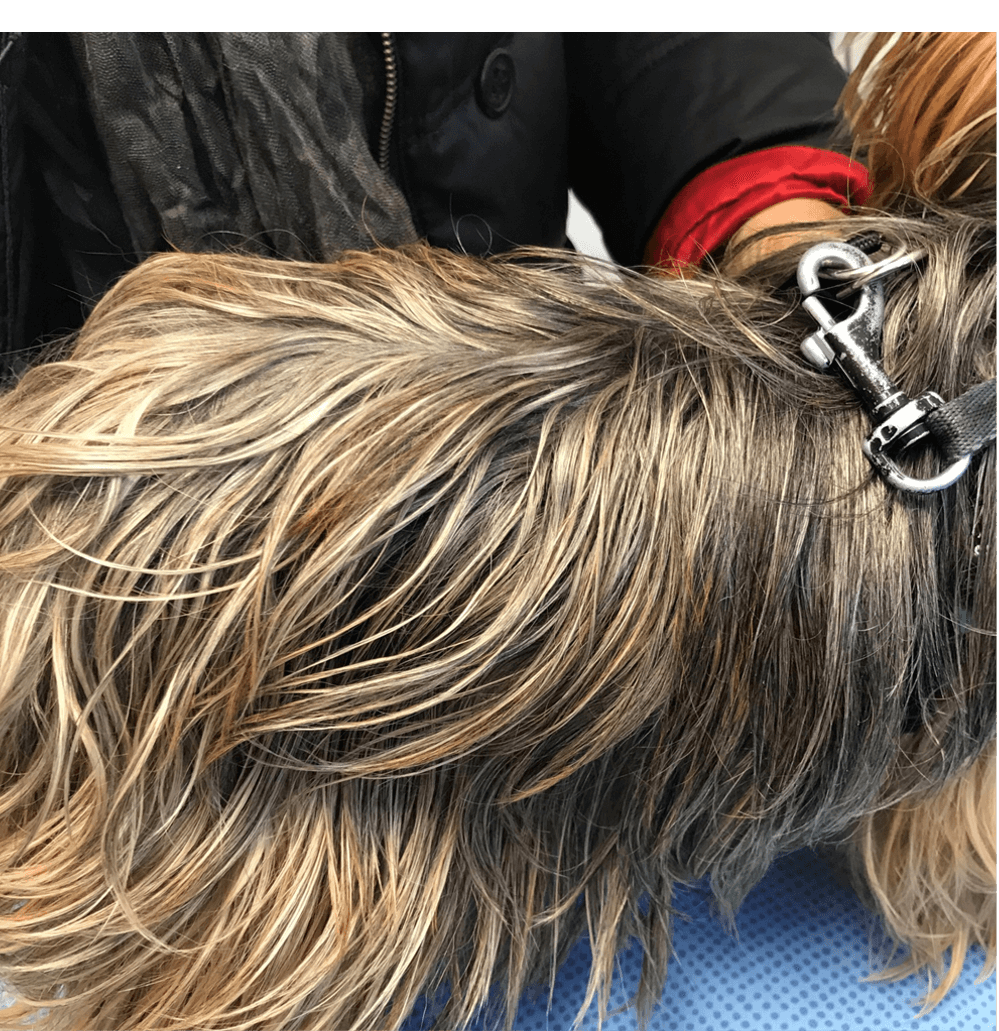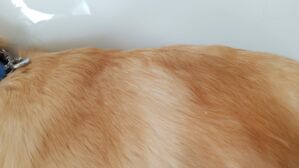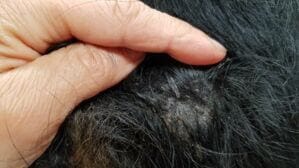Everything you need to know about seborrhea in dogs
Marina G VeterinarianSeborrhea alter your furry friend’s quality of the fur and sometimes generate unpleasant odours which is uncomfortable for all the family and can tentatively damage the human-animal bond. Finding the cause and quickly improve the coat’s quality are essential to restore the whole special relation with your dog.
Seborrhoea in dogs is a common condition, although it can often go unnoticed in milder cases as very discreet. It can be generalised and affect the whole of the dog’s skin, or more localised, affecting only small patches.
Where the skin is affected, it can be greasy and flaky (and in some cases, quite itchy for the dog) and it can be quite malodorous. Greasy, flaky, smelly skin can be damaging to the human-animal bond as fussing and allowing your dog up on furniture can be something many owners steer away from when skin is so affected.
What are the signs of seborrhoea?
Dogs may have a greasy, oily coat, occasionally comedones (blackheads) and an unpleasant odour coming from the skin in cases of oily seborrhoea. Depending on the cause, sometimes hair loss, skin redness, skin hyperpigmentation can be noticed. Signs can be generalised or more localised to a specific area.
Dogs with dry seborrhoea will more commonly have dry, flaky skin and dandruff. Hyperpigmentation (darkening of the skin) can occur as well as skin redness and you may see patches of hair loss (alopecia) in the affected areas of the body.
Itchiness is generally not present at the onset but can occur with worsening of the signs and/or development of a secondary bacterial or yeast infection that are common when the skin barrier is compromised.
Why do dogs have seborrhoea?
Actually, there are two types of seborrhoea or ‘seborrhoeic dermatitis’: dry (seborrhoea sicca) and oily (seborrhoea oleosa). Many dogs have a combination of both.
Canine oily seborrhoea is a skin disorder in which the sebaceous glands of the skin produce an excessive amount of an oily substance called sebum.
Normal skin is replaced in a three-week cycle. Dry seborrhoea occurs when there is an imbalance between the new and dying skin cells.
Seborrhoea can be a primary disorder or secondary to another skin or metabolic condition. In the huge majority of the cases, seborrhoea is secondary. The age, sex and breed of the dog may provide some clues for the underlying cause of disease.
Seborrhoea, a rare condition itself
Primary inherited seborrhoea normally appears in dogs by two years of age and becomes progressively worse over time. The most common breeds that present with primary seborrhoea are the West Highland White Terrier, Cocker Spaniel, Basset Hound, Dachshund, German Shepherd, Labrador Retriever and Golden Retriever. The most known primary seborrhoea disorders include ichthyosis, a skin condition which prevents the outer layer of skin from developing properly (well-known in Golden Retriever dogs), and sebaceous adenitis, another fairly uncommon skin disorder in which there is an inflammatory process against the sebaceous glands in the skin.
Seborrhoea, often a consequence of another disorder
The secondary cause of disease is more common. It can be caused by:
- Parasites, such as fleas, ticks and mange mites
- Fungal infection – most commonly, yeast skin infections (Malassezia)
- Allergies
- Environmental factors, such a cold, dry air, central heat
- Poor quality diet, with insufficient nutrients
- Hormonal imbalances (such as thyroid disease and Cushing’s Disease)
- Obesity
- A sequela of pain/ arthritis and poor grooming
Sometimes, no direct cause is found, which is termed ‘idiopathic.’ However, this diagnosis is made after the exclusion of all other possible causes.
When to go to the vet?
There are many potential underlying causes of dog seborrhea, and many require professional attention as if left untreated, it can worsen and lead to more serious problems.
While diagnosing the seborrhea itself is quite straightforward, determining the cause can be trickier, and apart from the environmental factors, your dog’s weight or food quality, this is best left in the hands of your vet.
If other clinical signs are present, such as: increased thirst or urination, increased appetite, itchiness, weight gain or loss and heat-seeking behaviour, then it is important to rule out metabolic illnesses that may result in seborrhoea.
How is seborrhoea diagnosed?
As causes of seborrhea are very diverse, your veterinarian may employ a few different techniques to reach a diagnosis of seborrhoea. This includes notably:
- Skin cytology, skin scrapes and hair plucks to rule out parasitic disease, and bacterial/ yeast dermatitis
- Blood tests to rule out underlying conditions such as thyroid disease, Cushing’s and diabetes and possibly explore allergies
- Skin test to explore allergies
- Skin biopsy to confirm diagnosis of primary seborrhoea
How can you help your seborrhoeic dog?
Apart from finding the cause and instaure an appropriate treatment with your vet, you can improve your dog skin condition with a general regimen of measures. In several situations (for example, endocrine disorders), the seborrhoea can be resolved by controlling the underlying disease, but this usually takes weeks to months. Other than treating the primary cause, it is important to rapidly improve skin appearance and bring comfort to your dog.
Apply topical products to regulate sebum and flakes production
Anti-seborrhoeic topicals are intended to regulate sebum production or flakes formation.
Dogs with greasy seborrhoea need their skin to be degreased while keeping a proper skin hydration. Sometimes excessive removal of grease can damage the epidermis and alter epidermal hydration, that is why the choice of the product used is crucial. Dogs with dry scaling need normalisation of their skin cell turnover, elimination of scales and hydration of the skin.
Seboliance, contained in DOUXO® S3 SEB line has seboregulating properties, restore normal cell turnover preventing the formation of flakes and helps prevent yeast overgrowth that is favored in seborrhoeic conditions. Ophytrium, in addition to other complementary ingredients in the formula allows for the maintenance of proper skin hydration, soothe itch if present and prevent adhesion of potentially pathogenic bacteria.
The line is available in shampoo and mousse for perfect complementarity: the shampoo is used for initial bathing, removing grease, dandruff and then the mousse applied every 2 to 3 days or as directed by your veterinarian enables the ingredients long-lasting skin contact.
Ensure a good grooming regime is in place
Regular brushing of your dog’s coat helps to remove dead skin cells, allows air to get to the skin, and distributes natural oils evenly across the skin.
Feed a good quality diet
Ensuring good nutrition and a healthy diet is vital in the health of the skin. You can start by talking to your vet about a well-balanced commercially available dog food. Also, supplementation of certain factors may help the clinical outcome. Fatty acid supplementation (omega-3) is essential for normal skin cell function and can aid in correcting seborrhoeic dermatitis. Fatty acids provide nourishment, allowing for a healthy production of sebum, thereby improving the coat quality and protecting the skin. Feeding a diet rich in omega-3 may help reduce inflammation and improve coat quality.
Treat the underlying cause under the direction of your vet
Treatment includes of course correction of the underlying cause, such as controlling food allergies by avoiding the ingredients your dog is allergic to, treating for fleas and maintaining preventative flea control moving forwards, or gaining a diagnosis and then medicating, as directed by your vet, to treat metabolic diseases such as hypothyroidism. Without correcting the underlying cause, any further treatment for the skin will likely fail.
For dogs with idiopathic, or primary seborrhoea, then the objective is to control the skin problem, as there is no definitive cure for the condition.
If there are signs of antibiotic or fungal infection, then a course of antimicrobials will be initiated.
What is the prognosis?
Dogs with the primary form of disease will often need management for life, however, through perhaps a bit of trial and error and communication with your veterinarian, many cases can be treated very effectively. It is important to keep up with topical products and ensure your dog is on the most appropriate parasite treatment. Early treatment and intervention will also make a difference if you notice any abnormalities with your dog’s skin.
For those with secondary forms of the disease, as long as the underlying condition is being treated and managed, then the prognosis for seborrhoea is improved. Use of topical products can help to improve quicker the skin appearance and bring comfort to your dog as management of the underlying cause can take weeks to months.
We recommend
Our solution for oily to flaky skin
DOUXO® S3 SEB helps reduce dandruff, excess sebum and unpleasant odours, while hydrating and strengthening the skin’s ecosystem.



